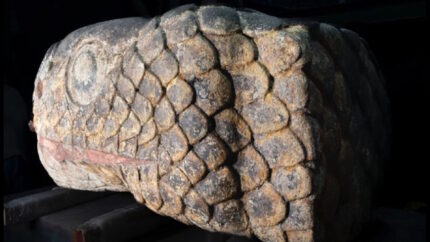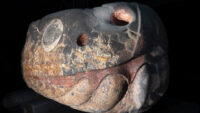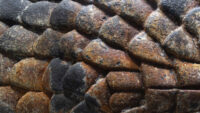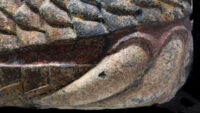 A colossal Mexica stone snake head sculpture unearthed in Mexico City last year is so well-preserved that almost all of its polychrome paint has survived in excellent condition. About 500 years old, the snake head still preserves the original color over 80% of its surface, making it the snake head with the greatest amount of surviving color ever discovered in ancient Tenochtitlan.
A colossal Mexica stone snake head sculpture unearthed in Mexico City last year is so well-preserved that almost all of its polychrome paint has survived in excellent condition. About 500 years old, the snake head still preserves the original color over 80% of its surface, making it the snake head with the greatest amount of surviving color ever discovered in ancient Tenochtitlan.
The snake head was discovered by a team from the Directorate of Archaeological Salvage (DSA) after a 7.6-magnitude earthquake struck Mexico City on September 19th, 2022. The colossal sculpture was exposed 15 feet under the east wing of the former law school of the National Autonomous University of Mexico (UNAM) in Mexico City’s historic downtown. The head alone is six feet long, 3.3 feet high, 2.8 feet wide and weighs an estimated 1.3 tons.
 It was not in its original context, but there were other architectural elements found nearby. The ground was muddy and waterlogged, a low-oxygen environment which preserved so much of the delicate painted stucco for five centuries. Saturated remains of ocher, red, blue, black and white decorate the scales, mouth, eyes and fangs of the serpent, a color palette frequently used by the Mexica on their religious images and temples.
It was not in its original context, but there were other architectural elements found nearby. The ground was muddy and waterlogged, a low-oxygen environment which preserved so much of the delicate painted stucco for five centuries. Saturated remains of ocher, red, blue, black and white decorate the scales, mouth, eyes and fangs of the serpent, a color palette frequently used by the Mexica on their religious images and temples.
 The National Institute of Anthropology and History (INAH) recovered the snake head the day after the earthquake. It is so massive and heavy it had to be raised with a crane and transported to the INAH conservation laboratory. The pigments used by the Mexica were derived from mineral and plant materials and are extremely fragile, so special measures had to be taken to protect the polychromy once the head was exposed to the air. A humidity chamber was constructed around it. The space is sealed with plastic liners that keep the relative humidity high. Sensors and data loggers monitor the levels at all times.
The National Institute of Anthropology and History (INAH) recovered the snake head the day after the earthquake. It is so massive and heavy it had to be raised with a crane and transported to the INAH conservation laboratory. The pigments used by the Mexica were derived from mineral and plant materials and are extremely fragile, so special measures had to be taken to protect the polychromy once the head was exposed to the air. A humidity chamber was constructed around it. The space is sealed with plastic liners that keep the relative humidity high. Sensors and data loggers monitor the levels at all times.
 The moisture will gradually be reduced to allow the snake head to slowly dry. This will ensure the water that has accumulated in the pores of the rock will rise to the surface slowly, preventing fading of the color, cracks and crystallization of the mineral salts. The stabilization process is expected to take until early next year.
The moisture will gradually be reduced to allow the snake head to slowly dry. This will ensure the water that has accumulated in the pores of the rock will rise to the surface slowly, preventing fading of the color, cracks and crystallization of the mineral salts. The stabilization process is expected to take until early next year.
The sculpture’s “sheer size is impressive, as well as its artistry,” but the survival of the colors is remarkable, said Frances Berdan, a professor emeritus of anthropology at California State University, San Bernardino who was not involved with the excavation. “The survival of black, white, red, yellow, and blue paints is particularly interesting — one gains a good image of the visual impact of such sculptures as they were arrayed about the city center,” Berdan told Live Science in an email.
In addition to its preserved colors, the snakehead’s size is notable, said Bertrand Lobjois, an associate professor of humanities at the University of Monterrey in Mexico who is not involved in the excavation. The “first time I saw this serpent head, I was dazzled by its dimensions,” he said in an email.
Lobjois also praised the conservation work that allowed the colors to survive, noting that “the conservation process allows us to appreciate the naturalistic approach of figuration” the Aztec artists used.